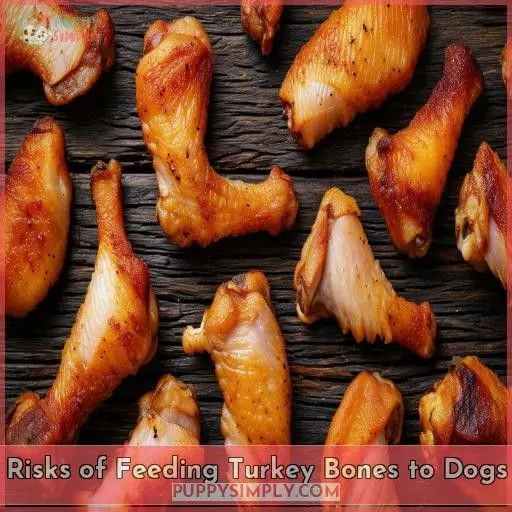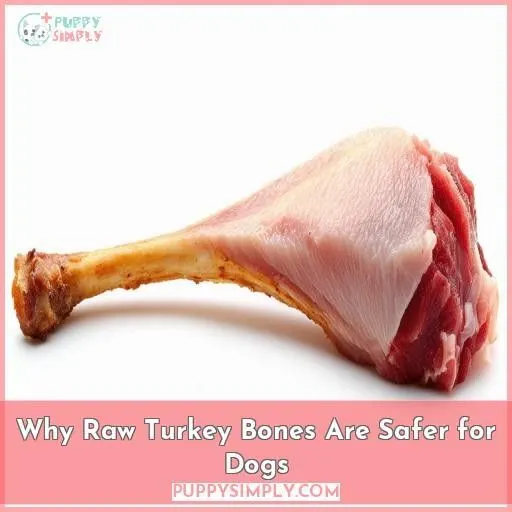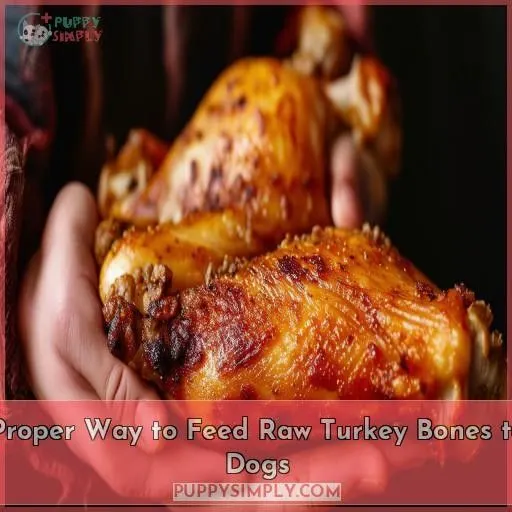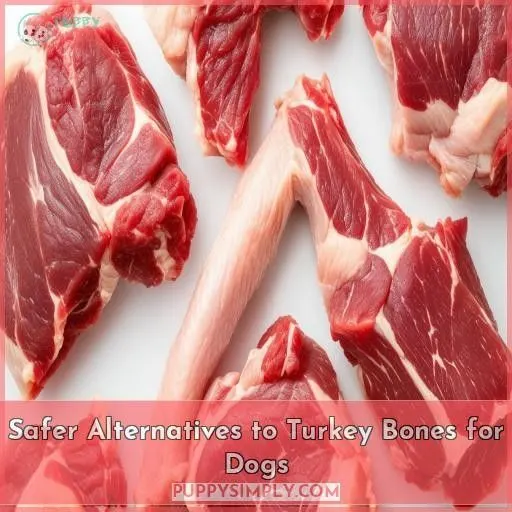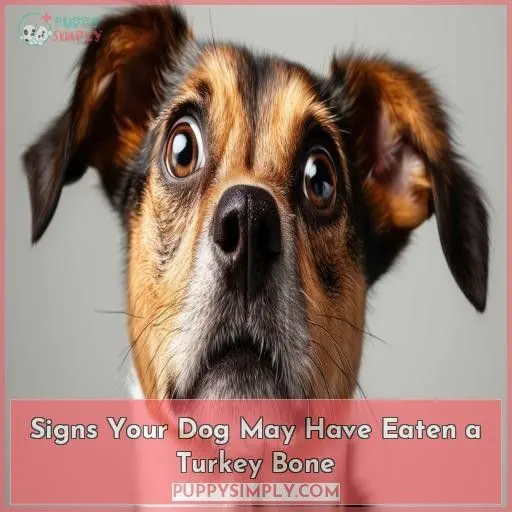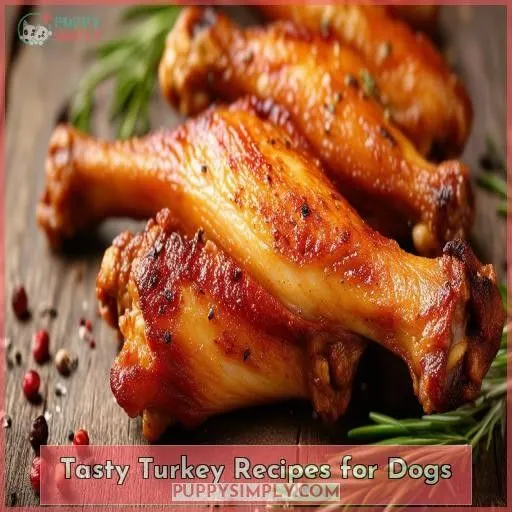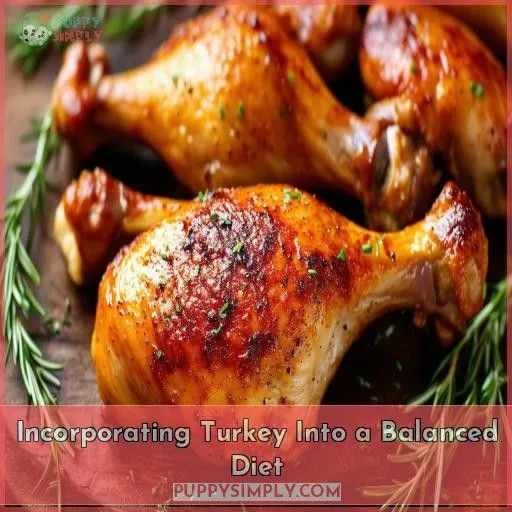This site is supported by our readers. We may earn a commission, at no cost to you, if you purchase through links.
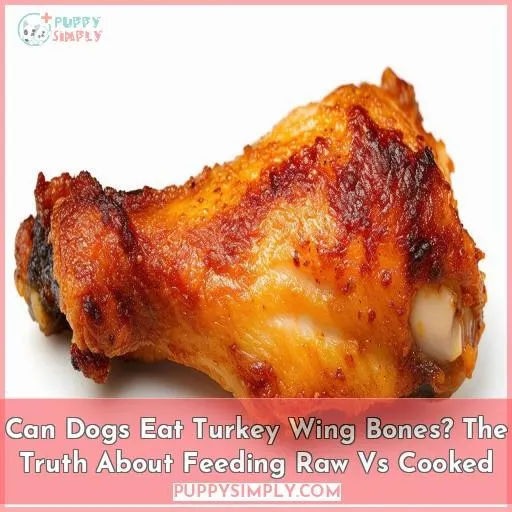
But don’t worry, you can still treat your pup! Raw turkey wing bones are okay. A dog’s powerful stomach acid helps break them down safely, and they provide nutrients like calcium.
Just introduce them gradually, pick appropriate sizes, and remove any sharp pieces. Still unsure? Safer alternatives like bully sticks or dental chews exist.
But if you want to give those meaty wings a try, I’ve got some tips that’ll have your furry friend tail-waggingly happy.
Table Of Contents
- Key Takeaways
- Can Dogs Eat Turkey Wing Bones?
- Risks of Feeding Turkey Bones to Dogs
- Why Raw Turkey Bones Are Safer for Dogs
- Proper Way to Feed Raw Turkey Bones to Dogs
- Safer Alternatives to Turkey Bones for Dogs
- Signs Your Dog May Have Eaten a Turkey Bone
- Tasty Turkey Recipes for Dogs
- Incorporating Turkey Into a Balanced Diet
- Frequently Asked Questions (FAQs)
- What happens if my dog eats a turkey bone?
- Are wing bones OK for dogs?
- Can I give my dog a raw turkey leg?
- Can my dog eat turkey thighs?
- Are turkey bones suitable for puppies?
- Can turkey bones cause dental issues?
- How to transition to raw diet?
- Is organic turkey better for dogs?
- What turkey parts are most nutritious?
- Conclusion
Key Takeaways
- Cooked turkey bones are a big no-no – they can splinter into razor-sharp shards and wreak havoc on your pup’s insides. It’s like playing a game of Russian roulette with their digestive tract.
- Raw turkey wing bones, on the other hand, are the safer choice for a tasty treat. Thanks to their powerful stomach acid, dogs can break them down without any major drama. Just make sure to keep an eye on your furry friend during chew time.
- If the idea of bones has you feeling like a helicopter parent, don’t sweat it! There are plenty of bone-free alternatives that’ll satisfy your dog’s chewing needs, like bully sticks or dental chews. Think of them as the kid-friendly version of turkey bones.
- When in doubt, remember that a balanced diet is the key to your pup’s health and happiness. Consulting your vet or a canine nutritionist can help you navigate the world of turkey and ensure your furry companion gets all the nutrients they need, minus the potential hazards.
Can Dogs Eat Turkey Wing Bones?
No, dogs shouldn’t eat turkey wing bones. Cooked turkey bones can splinter and cause internal damage or blockages, while raw bones pose a potential choking hazard.
Risks of Feeding Turkey Bones to Dogs
You should never feed cooked turkey bones to your dog. These bones can splinter into sharp pieces, potentially causing internal injuries like blockages or punctures to the digestive tract.
Cooked Bones Can Splinter and Cause Internal Damage
Cooked turkey bones pose serious risks to your pup’s health. They’re prone to splintering into sharp shards that can:
- Tear and puncture your dog’s mouth
- Scratch their esophagus or stomach lining
- Cause internal bleeding or infection
- Chip or break their teeth
Steer clear of feeding cooked bones from your table scraps. The potential for internal damage isn’t worth the gamble on your furry friend’s wellbeing.
Bones Can Cause Blockages or Puncture the Intestines
You don’t want bone fragments lodged in your pup’s digestive tract. Turkey wing bones can easily splinter, creating sharp shards that puncture the intestines or cause blockages. Even small bone pieces pose choking hazards. Avoid the risks with this simple rule:
| Cooked Turkey Bones | Raw Turkey Bones |
|---|---|
| Never Feed | Okay to Feed |
| Splinter Hazard | Digest Naturally |
| Intestinal Blockages | Provide Nutrients |
| Potential Punctures | Dental Benefits |
| Vet Visit Required | Monitor Closely |
Cooked turkey bones are off-limits, but raw ones are generally safe when fed properly. Stay vigilant to keep your furry friend healthy.
Why Raw Turkey Bones Are Safer for Dogs
Raw turkey bones are safer for dogs to consume because they’re softer and more pliable, reducing the risk of splintering. Additionally, a dog’s strong stomach acid helps break down raw bones, allowing them to digest the nutrients like calcium and phosphorus.
Raw Bones Are Softer and Less Likely to Splinter
In contrast, raw turkey bones are much safer for your furry friend. They’re softer and far less likely to splinter into sharp pieces that could puncture their insides. Just be mindful of bone size and source – fresh, appropriately-sized raw bones from a butcher are ideal.
Dogs’ Strong Stomach Acid Helps Break Down Raw Bones
raw turkey wing bones are safer for dogs thanks to their strong stomach acid. It can:
- Break down raw bones more easily
- Kill harmful bacteria
- Aid in nutrient absorption
Feeding appropriate portions under supervision allows dogs to benefit from raw bones’ digestive and nutritional value. Their stomach acid is nature’s way of helping them enjoy this tasty, healthy treat.
Raw Bones Provide Nutrients Like Calcium and Phosphorus
Raw bones also offer digestive benefits for your pup. With nutrients like calcium for bone strength and phosphorus for cellular energy, turkey wing bones support overall health. Here’s a quick breakdown:
| Nutrient | Benefit |
|---|---|
| Calcium | Aids calcium absorption for strong bones/teeth |
| Phosphorus | Facilitates nutrient absorption, energy production |
| Cartilage | Provides glucosamine for joint health |
Proper Way to Feed Raw Turkey Bones to Dogs
When introducing raw turkey bones to your dog’s diet, start with appropriately sized pieces and monitor them closely as they chew. Remove any remaining bone fragments afterward to prevent potential choking hazards.
Introduce Raw Bones Gradually and Monitor Closely
So, when feeding raw turkey bones, it’s essential to introduce them gradually and monitor closely. Here’s what to keep in mind:
- Supervision required: Never leave your dog unattended with bones
- Chewing concerns: Remove any sharp pieces that break off
- Portion control: Start with small amounts until accustomed
- Introduce gradually: Give bones over several days/weeks
Provide Appropriately Sized Bones for Your Dog’s Size
When feeding raw turkey bones, it’s vital to select suitably sized ones for your dog’s breed. Large-breed dogs can handle turkey necks or wing tips, while smaller dogs should stick to smaller, softer bones. Keep a close eye on your pup during chewing sessions to verify that they don’t bite off pieces too large to swallow safely.
Remove Any Remaining Bone Pieces to Prevent Choking
After your dog finishes chewing the properly-sized turkey wing bone, carefully remove any remaining small pieces or shards to prevent choking hazards. Choose a designated feeding area away from furniture to make clean-up easier, and limit treat portions to avoid overindulging and digestive issues. Regular dental cleanings also help manage potential choking risks.
Safer Alternatives to Turkey Bones for Dogs
Instead of turkey bones, offer dental chews or bully sticks to satisfy your dog’s need to chew while avoiding potential risks. Always consult your veterinarian for personalized recommendations to guarantee your dog’s safety and well-being.
Try Dental Chews or Bully Sticks for Chewing Satisfaction
If your dog craves chewing, try dental chews or bully sticks instead of turkey bones. These safer alternatives satisfy their chewing needs without risking dental issues or internal injuries. Dental chews help clean teeth while bully sticks provide long-lasting chewing enjoyment from a single muscle source. Explore other safe foods like white turkey meat for variety.
Consult With Your Veterinarian for Personalized Recommendations
While dental chews and bully sticks offer safer alternatives, consulting your vet is essential. Every dog is unique, so your vet can:
- Evaluate your pup’s specific needs and risks
- Recommend suitable chew options based on size, breed, and health
- Advise on incorporating turkey into a balanced, nutritious diet
Your vet’s personalized guidance ensures your furry friend stays safe, satisfied, and gets the nutrients they need from treats and meals.
Signs Your Dog May Have Eaten a Turkey Bone
If your dog starts vomiting, experiences diarrhea or constipation, loses their appetite, or appears lethargic after eating turkey bones, these could be signs they’ve ingested a bone. Abdominal pain or discomfort may also indicate a bone has punctured or blocked their digestive tract, so monitor closely for these concerning symptoms.
Vomiting, Diarrhea, or Constipation
If your dog’s vomiting, having diarrhea or constipation, it could mean they’ve eaten a turkey bone. This table shows other warning signs:
| Symptom | Description |
|---|---|
| Abdominal Pain | Yelping, arched back |
| Lethargy | Lack of energy |
| Lack of Appetite | Not eating |
Seek medical attention immediately if you notice these signs.
Loss of Appetite or Lethargy
If your pup stops eating or seems unusually sluggish after ingesting turkey wing bones, it could indicate a blockage. Loss of appetite and lethargy are red flags that your furry friend needs veterinary attention immediately, as bones – cooked or raw – can wreak havoc on their digestive system.
Abdominal Pain or Discomfort
Another telltale sign your dog ate a turkey bone is abdominal pain or discomfort. If they’re squirming, whimpering, or avoiding being touched around their belly, it could indicate an obstruction or puncture wound from the bone. Keep a close eye and contact your vet immediately if this concerning symptom arises.
Tasty Turkey Recipes for Dogs
You can treat your pup to nutritious homemade meals like turkey meatballs with veggies, turkey and sweet potato stew, or turkey and brown rice casserole. These recipes provide lean protein from turkey while incorporating healthy fruits, vegetables, and grains for a well-balanced diet.
Turkey Meatballs With Vegetables
For tasty turkey meatballs with veggies, combine turkey breast, grated vegetables, and an egg. Form into balls, bake at 375°F for 20 minutes. These meatballs provide lean protein, fiber, and nutrients. Refrigerate leftovers promptly. Avoid turkey wing tips which can splinter.
Turkey and Sweet Potato Stew
Try this healthy homemade turkey and sweet potato stew. The lean turkey provides protein, while sweet potatoes offer fiber and nutrients. Turkey bone broth adds flavor and digestive benefits. A tasty, balanced treat your pup will love!
Turkey and Brown Rice Casserole
Another tasty treat is a turkey and brown rice casserole. You can mix shredded turkey with cooked brown rice, veggies like carrots and green beans, and low-sodium broth. Portion it into servings and store leftovers properly. It’s a nutrient-dense meal that’s easy on sensitive stomachs.
Incorporating Turkey Into a Balanced Diet
You’re wise to ponder how turkey fits into your dog’s overall diet. When incorporating turkey as a lean protein source, introduce it gradually and consult your vet or a canine nutritionist to guarantee your pup receives balanced meals with the right nutrients.
Turkey is a Lean Protein Source High in Nutrients
Turkey is a tasty treat and packed with nutrients your pup needs. It’s a lean protein source rich in iron, zinc, and B vitamins. From turkey meatballs to bone broth, there are many healthy ways to incorporate this nutritious meat into your dog’s balanced diet.
Introduce Turkey Gradually to Avoid Digestive Upset
Since turkey is a novel protein for your pup, introduce it gradually to avoid digestive upset. Try:
- Adding small amounts to their current food
- Offering turkey-based treats or dental chews
- Supplementing with digestive enzymes or bone broth
- Monitoring for signs of digestive issues like vomiting or diarrhea.
Going slow allows their body to adjust to the new turkey diet.
Consult With a Canine Nutritionist for Personalized Feeding Advice
For the best possible dog health, consult a canine nutritionist. They’ll provide personalized dietary guidance on safe bone portions, raw vs. cooked preferences, and balanced turkey incorporation. Their expertise ensures proper nutrition, considering your dog’s size, age, and activity level.
Frequently Asked Questions (FAQs)
What happens if my dog eats a turkey bone?
Listen, if your pup snatched a turkey bone, it could spell real trouble. Those brittle shards can slash their insides and cause blockages. Carefully watch for vomiting, bloody stools, or lethargy, and don’t hesitate to call your vet. With quick action, you can prevent the worst.
Are wing bones OK for dogs?
You should avoid giving your dog cooked turkey wing bones. They can splinter and cause internal injuries or blockages. Raw bones may be safer, but monitor your pup closely and remove any small pieces to prevent choking hazards.
Can I give my dog a raw turkey leg?
While turkey bones may seem tempting, raw turkey leg bones can pose serious risks. They’re too large and dense, potentially causing obstructions or punctures. Save your pup’s health by providing appropriate chew toys and lean turkey meat instead.
Can my dog eat turkey thighs?
Yes, you can feed your dog turkey thighs. Bone-in turkey meat is safe for dogs when cooked thoroughly and served without seasonings. Just be sure to supervise your pup to prevent choking hazards.
Are turkey bones suitable for puppies?
No, puppies shouldn’t eat turkey bones – weed out that unhealthy idea! Their delicate mouths and digestive systems aren’t ready for potential splintering, blockages or internal injuries. Stick to soft, puppy-approved treats until their systems fully develop.
Can turkey bones cause dental issues?
Yes, turkey bones can indeed cause dental issues in dogs. These bones are rigid and can fracture or chip your pup’s teeth, leading to painful dental problems. It’s best to avoid giving turkey bones to your furry friend to keep their chompers healthy.
How to transition to raw diet?
Gradual changeover by blending raw with current diet. Consult a vet initially to verify its suitability. Progressively increase raw portions over 6-8 weeks for ideal digestive adaptation.
Is organic turkey better for dogs?
Organic turkey is an excellent choice for your pup. It’s free from antibiotics, hormones, and harmful chemicals, making it a safer, more nutritious option. Just be sure to monitor portion sizes and avoid cooked bones, as they can splinter and cause injuries.
What turkey parts are most nutritious?
Turkey necks and gizzards offer dense nutrition, packed with protein, vitamins, and minerals to support your pup’s health. The lean turkey breast meat also provides an easily digestible protein source. Always monitor your dog closely when introducing new foods.
Conclusion
Around 10% of pet owners have fed raw bones, a risky practice.
While raw turkey wing bones can provide nutrients, it’s vital to weigh the risks.
For safe chewing, opt for dental chews or bully sticks.
If you choose to feed raw turkey wing bones, introduce them gradually, monitor closely, and consult your vet for personalized advice.
Ultimately, a balanced diet with lean turkey meat is a safer way to nourish your furry friend.

